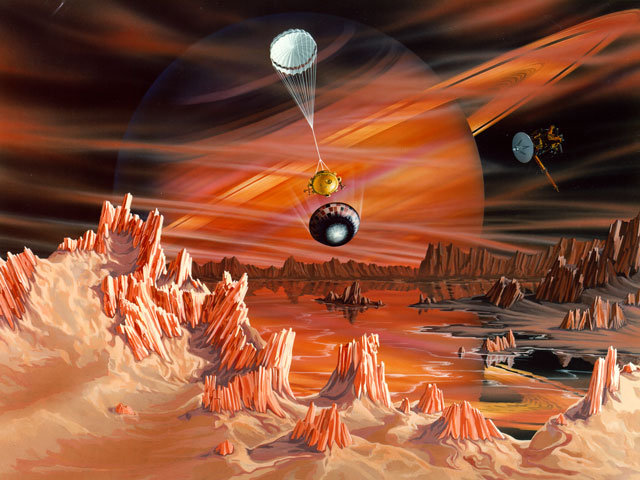Explanation: What does the surface of Titan look like? Thick clouds have always made Saturn's largest moon so mysterious that seemingly farfetched hypotheses like methane rain and lakes have been seriously considered. Later this week, the Cassini spacecraft orbiting Saturn is scheduled to release its probe named Huygens that will actually attempt to land on the shrouded moon in early January. Sketched above is one educated guess of what Huygens might find. In the above depiction, orange hydrocarbons color a landscape covered with lakes and peaks of frozen methane and ammonia. For illustration purposes, the Huygens probe is drawn parachuting down with an oversized Cassini spacecraft orbiting above. Saturn, likely occluded by the clouds, is depicted looming in the distance. What will Huygens really find? Are the building blocks of life frozen onto the surface of Titan? Will the truth be stranger than we imagined?
News: APOD editor to speak in January in New York
1999 2000 2001 2002 2003 2004 2005 2006 2007 2008 2009 2010 2011 2012 2013 2014 2015 2016 2017 2018 2019 2020 2021 2022 2023 2024 2025 |
Yanvar' Fevral' Mart Aprel' Mai Iyun' Iyul' Avgust Sentyabr' Oktyabr' Noyabr' Dekabr' |
NASA Web Site Statements, Warnings, and Disclaimers
NASA Official: Jay Norris. Specific rights apply.
A service of: LHEA at NASA / GSFC
& Michigan Tech. U.
|
Publikacii s klyuchevymi slovami:
Titan - Saturn - Huygens probe - Titan - Saturn - zond Gyuigens
Publikacii so slovami: Titan - Saturn - Huygens probe - Titan - Saturn - zond Gyuigens | |
Sm. takzhe:
Vse publikacii na tu zhe temu >> | |
